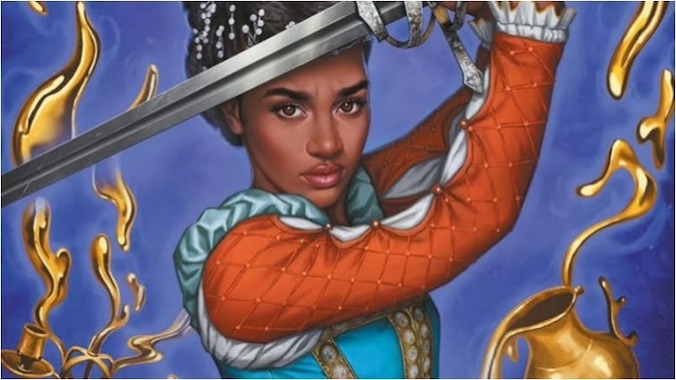If We Shadows Have Offended: Fighting the Fae in Brittany N. Williams’s Saint-Seducing Gold

The year is 1606. Queen Elizabeth is dead, King James has taken over patronage of William Shakespeare’s theater troupe (now the King’s Men), and Joan Sands is in over her head when it comes to the fae who are invading England. That’s the premise of Brittany N. Williams’s “Forge & Fracture” Saga, which continues in this month’s release, Saint-Seducing Gold. The books are infused with drama—both on stage with the players and on the streets of London—swordplay, romance, murder, and mischief. Williams leans heavily into her Shakespearean influences, brings to life a system of magic inspired by Orisha worship, and presents her fae as both monstrous and beautiful.
To set the scene, when Joan takes the stage of That Self-Same Metal, which came out a year ago, the audience sees her world for the first time: the Globe Theater, where she works with the King’s Men as their fight coordinator. Joan is a gifted choreographer and fighter, in part because of her unique connection with Ogun, the Orisha of iron and war. Ogun’s blessing allows Joan to shape metal, especially iron, which makes her gifted in all sorts of metal work, including dulling the stage blades to make them less dangerous to her actors (who do not always follow her directions as well as they should). She and the other Orisha worshippers of London can see fae in their midst—it’s a blessing from their patrons—and they’ve long known that creatures of magic exist side by side with humanity. But something has shifted the balance, and when Joan overhears her godfather, Baba Ben, explaining that the king must renew “the Pact” or things will go badly, she begins to get a peek into the very, very bad things that are about to happen.
Without the king’s willingness to believe in something he dismisses as superstition, Baba Ben is arrested, and the Pact falls, and the fae—the most dangerous ones among them—are no longer bound to simple acts of mischief. Fae who were banished to the fairy world entirely are now free and roaming about, causing devastation wherever they walk. One of them, Auberon, seems to be the greatest threat, and after Joan foolishly saves the life of a young man, she gains the attention of Lord Salisbury, the king’s spymaster. He tasks her with killing Auberon and ending the fae threat, or he’ll bring harm to her family.
To avoid detailed spoilers, it seems by the end of That Self-Same Metal that Joan has at least brought some stability back to London, though it has gained her the unwanted eye of the spymaster, who remains a danger to her entire family. But as the early pages of Saint-Seducing Gold open, readers learn that the fae threat is still only beginning, and Joan has far greater enemies to worry about. Titanea has disguised herself as Queen Anne and is infiltrating the Royal Court. To make matters worse, she’s taken a liking to Joan and intends to keep her close, ordering her to become a lady-in-waiting. While this elevates Joan’s status, it also tears her from everything she cares about: her father’s goldsmithing, the King’s Men, her beloved twin brother, James, and one of the actors, Nick Tooley, with whom she hopes she might one day reach an understanding. It also puts her once again in the path of Lord Salisbury, who is determined that Joan’s rising star should fall in the most disastrous way possible—even if he has to accuse her of witchcraft and see her burned.
With the help of Rose, the half-mortal daughter of Robin Goodfellow, Joan navigates the court, hoping to find a way to rescue her godfather from the Tower of London and re-establish the Pact before Titanea causes more harm. But there are limits to what Joan can do, and secrets she may not be able to keep. And as the danger grows, so does the violence, and Joan knows there’s no way to save everyone she loves.
-

-

-

-

-

-

-

-

-

-

-

-

-

-

-

-

-

-

-

-

-

-

-

-

-

-

-

-

-

-

-

-

-

-

-

-

-

-

-

-








































